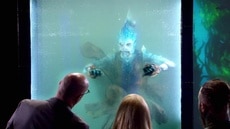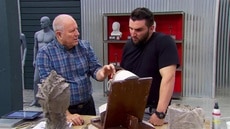Create a free profile to get unlimited access to exclusive videos, sweepstakes, and more!
NASA takes a dip in Space Center pool to test new moon-bound spacesuits

The fall weather may be dropping temperatures around the country, but that's not stopping NASA from getting its feet wet and taking a plunge in a refreshing test pool at the space agency's Johnson Space Center in Houston.
With the moon-bound Artemis program slated for a 2024 launch to land on and explore the lunar South Pole, extravehicluar activity (EVA) will play a major role in the project's parameters, requiring astronauts in next-generation spacesuits to take strolls and conduct experiments within the hostile environment of the moon's magnificent desolation.
To prepare for the next historic moon landing, NASA engineers are now putting these new spacesuits through the wringer in anticipation of the first woman and next man to step foot onto lunar soil by testing the equipment and demonstrating training logistics for lunar surface operations. Taking place at the Space Center's Neutral Buoyancy Lab (NBL), these exploratory operations include astronauts diving into the pool while zipped up inside demo versions of the official exploration spacesuit. They're accompanied by NASA engineers in “hard hat” dive equipment replicating various tasks the team might be asked to engage in while on the Moon.
“This early testing will help determine the best complement of facilities for hardware development and requirements for future Artemis training and missions,” explained Daren Welsh, extravehicular activity test lead for these Artemis preparation test runs. “At the same time, we are going to be able to gather valuable feedback on spacewalk tools and procedures that will help inform some of the objectives for the missions.”
These underwater maneuvers are targeting and evaluating Johnson’s aquatic facilities for Artemis' vital spacewalk testing, development, and crew training. Astronauts immersed in simulated lunar gravity are engaged in a number of mission tasks such as scooping up samples of dusty lunar regolith, inspecting the structure of a lunar lander, and even planting an American flag.
While daily tasks might seem simple in the comfort of Earth's gravity, scientists want to witness the team carrying out routine chores and activities, including mounting and descending ladders, grasping and utilizing tools, and most importantly, safely embarking on moonwalks in much more challenging lighting conditions than the old Apollo mission jaunts completed in bright sunlight.
Training astronauts for microgravity spacewalks is something NASA has been proficient in for the past two decades, especially for long excursions to the International Space Station. But Moon missions and all the extra hazards are an entirely different endeavor.
“We can evaluate tools in a lab or the rock yard, but you can learn so much when you put a pressurized spacesuit on and have to work within the limitations of its mobility,” Welsh added. “These NBL runs are so valuable for understanding the human performance component and ensuring our astronauts are as safe as possible.”
Artemis teams are also experiencing outdoor environments that replicate other lunar conditions like Johnson Space Center's expansive rock yard, a huge, boulder-strewn test arena that simulates the uneven terrain of the lunar surface.
Rock yard routines emphasize close interactions between astronauts and the Earth-based mission control teams and science control centers to help engineers develop smoother procedures during critical mission operations. Testing also aids NASA in revealing better spacewalking tool design and helps dictate overall operational timelines for difficulty and duration.
“We have experience with space station, but we need to determine how we’re going to train the crew for surface operations during these specific missions,” Welsh said. “There is a lot of work to do to get the facilities ready to work for lunar missions and figure out how to facilitate the training.”




























